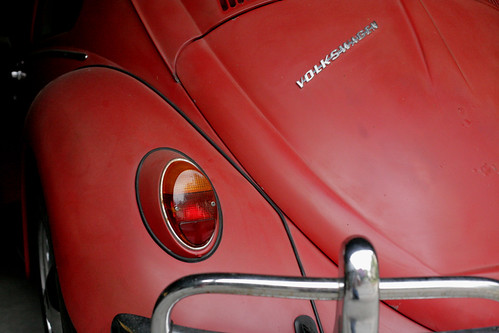 In our last episode, we left the little red car sitting in the driveway airing itself out after the carburetor needle valve had failed and allowed the engine to fill up with raw gasoline. I called ahead to my BCE, the VW parts store that I’ve been patronizing for the last 29 years, to make sure they had the parts I needed. They did. I drove one of my other cars up there to pick them up. On the way back, I stopped at big chain parts store and picked up three quarts of oil.
With the needed parts in hand, the problem was easily fixed. I threaded the spark plugs back into the cylinder heads, replaced the crankcase drain plug, and dumped in the three quarts of oil. To replace the needle and seat and the float was simply an matter of removing the four screws that hold the top of the carburetor in place and lifting it off. I removed the defective needle and seat and replace it with the new set. For good measure, I also replaced the float. I put the top back on the carburetor, screwed it down and climbed into the driver’s seat. I turned the ignition on with the key and let the electric fuel pump run for a minute to fill up the carburetor float chamber. When I engaged the starter, the engine fired right up and ran just fine except that it wouldn’t idle.
That was an easy problem to figure out. The bad needle valve had been letting fuel into the carburetor all the time and thus was affecting the idle speed. Without that excess fuel, I needed to readjust the idle screws so that the engine was getting the correct amount of fuel to idle. Once that adjustment was done, the car ran beautifully and has been working fine ever since.
For the future, to prevent this from happening again, I am going to install a fuel shut-off valve in the engine compartment so that, if I ever have to park the car nose-up on a hill, I can shut off the fuel. Every motorcycle I have ever owned had a fuel shut-off valve. In solving this problem, I realized why. On a motor cycle, the fuel tank is above the engine and, thus, the fuel can easily fill up the engine if there is a leak. This is only a problem on carbureted engines. Fuel injected engines have other potential problems, but flooding due to bad carburetor needle valves isn’t one of them.
Another lesson learned. Another problem solved. The moral of this story is: If it has moving parts, eventually one or all of them will wear out and fail.
In our last episode, we left the little red car sitting in the driveway airing itself out after the carburetor needle valve had failed and allowed the engine to fill up with raw gasoline. I called ahead to my BCE, the VW parts store that I’ve been patronizing for the last 29 years, to make sure they had the parts I needed. They did. I drove one of my other cars up there to pick them up. On the way back, I stopped at big chain parts store and picked up three quarts of oil.
With the needed parts in hand, the problem was easily fixed. I threaded the spark plugs back into the cylinder heads, replaced the crankcase drain plug, and dumped in the three quarts of oil. To replace the needle and seat and the float was simply an matter of removing the four screws that hold the top of the carburetor in place and lifting it off. I removed the defective needle and seat and replace it with the new set. For good measure, I also replaced the float. I put the top back on the carburetor, screwed it down and climbed into the driver’s seat. I turned the ignition on with the key and let the electric fuel pump run for a minute to fill up the carburetor float chamber. When I engaged the starter, the engine fired right up and ran just fine except that it wouldn’t idle.
That was an easy problem to figure out. The bad needle valve had been letting fuel into the carburetor all the time and thus was affecting the idle speed. Without that excess fuel, I needed to readjust the idle screws so that the engine was getting the correct amount of fuel to idle. Once that adjustment was done, the car ran beautifully and has been working fine ever since.
For the future, to prevent this from happening again, I am going to install a fuel shut-off valve in the engine compartment so that, if I ever have to park the car nose-up on a hill, I can shut off the fuel. Every motorcycle I have ever owned had a fuel shut-off valve. In solving this problem, I realized why. On a motor cycle, the fuel tank is above the engine and, thus, the fuel can easily fill up the engine if there is a leak. This is only a problem on carbureted engines. Fuel injected engines have other potential problems, but flooding due to bad carburetor needle valves isn’t one of them.
Another lesson learned. Another problem solved. The moral of this story is: If it has moving parts, eventually one or all of them will wear out and fail.
some updates
1 week ago




This comment has been removed by a blog administrator.
ReplyDeleteThis comment has been removed by a blog administrator.
ReplyDeleteThis comment has been removed by a blog administrator.
ReplyDeleteThis comment has been removed by a blog administrator.
ReplyDeleteThis comment has been removed by a blog administrator.
ReplyDeleteThis comment has been removed by a blog administrator.
ReplyDelete